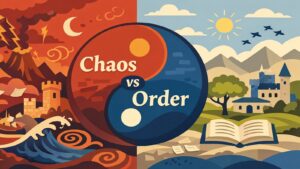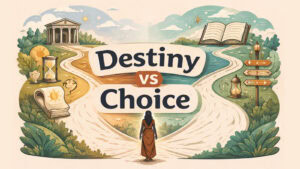Table of Contents
Introduction: Worldbuilding as the Psychology of Storytelling
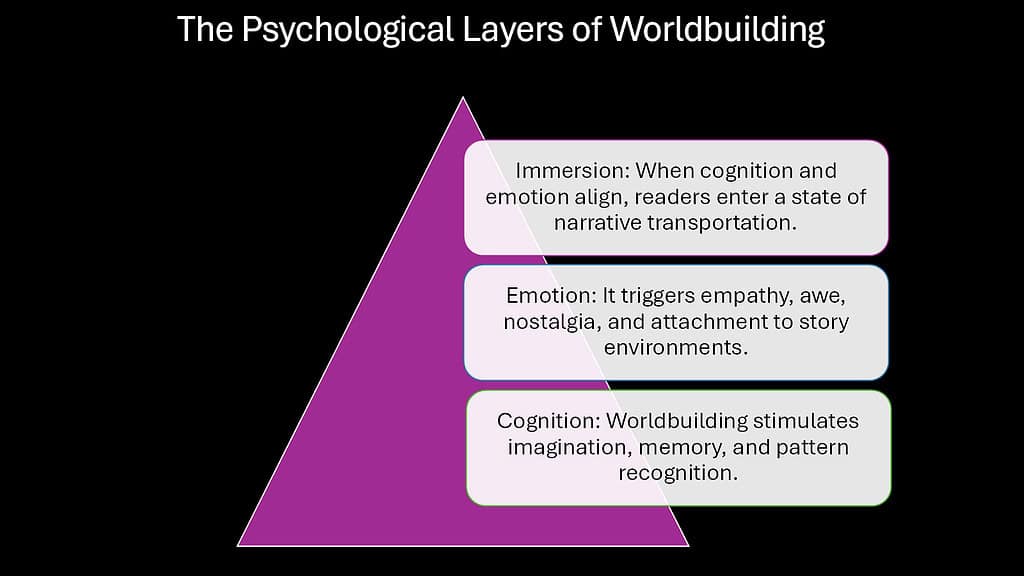
Worldbuilding represents one of storytelling’s most powerful psychological forces, operating beneath conscious awareness to shape how readers process narrative information. Unlike simple background details that merely provide context, effective worldbuilding creates comprehensive mental frameworks that help readers navigate complex narratives with confidence and emotional investment. It builds essential emotional bridges between fictional experiences and real human psychology, enabling profound connections that make imaginary worlds feel genuinely meaningful. When writers construct believable worlds, they tap into fundamental cognitive processes that govern how people understand reality itself, creating experiences that feel both fantastical and authentically human.
This psychological approach to worldbuilding transforms passive readers into active participants in the storytelling process. The human brain naturally seeks patterns, logical connections, and systematic understanding in all experiences. Well-crafted story worlds satisfy these deep cognitive needs while simultaneously creating expansive space for imagination to flourish and grow. Readers don’t just observe these worlds from a distance; they inhabit them mentally, emotionally, and sometimes spiritually, forming personal relationships with fictional places that can last lifetimes.
The six strategies explored here demonstrate how worldbuilding functions as narrative psychology rather than mere decoration. Each approach connects to established literary frameworks while addressing practical storytelling challenges. These methods help writers create immersive experiences that feel authentic and emotionally compelling.
Table 1: Worldbuilding Compared to Other Storytelling Psychologies
| Storytelling Psychology | Primary Function | Reader Impact | Psychological Mechanism |
|---|---|---|---|
| Worldbuilding | Creates immersive frameworks | Deep engagement and belief | Cognitive mapping and pattern recognition |
| Narrative Hook | Captures immediate attention | Initial curiosity and momentum | Attention activation and mystery response |
| Mirror Effect | Reflects reader experiences | Personal connection and identification | Self-recognition and empathy triggers |
| Suspense | Maintains tension and uncertainty | Emotional investment and anticipation | Anxiety and curiosity arousal |
| Emotional Arc | Guides feelings through story | Cathartic release and satisfaction | Emotional regulation and processing |
| Twist and Reframe | Challenges assumptions | Surprise and cognitive restructuring | Mental model revision |
| Subtext | Communicates hidden meanings | Deeper understanding and interpretation | Implicit learning and inference |
| Moral Framing | Presents ethical dimensions | Value reflection and judgment | Moral reasoning and conscience activation |
1. Worldbuilding and the Hero’s Quest in Storytelling
Joseph Campbell’s Hero’s Quest provides a powerful analytical lens for understanding how worldbuilding supports archetypal storytelling patterns that resonate across cultures and generations. The hero’s transformative path becomes genuinely believable only when the world itself accurately reflects the psychological stages of personal transformation and growth. Effective worldbuilding creates external landscapes that mirror internal character development, establishing symbolic connections between environment and emotional state that readers intuitively understand and appreciate.
The ordinary world must feel genuinely ordinary, comfortable, and familiar to establish a meaningful contrast with the extraordinary adventure ahead. When Bilbo Baggins inhabits his comfortable hobbit-hole, Tolkien’s detailed description of Hobbiton’s pastoral serenity creates deep psychological safety for both character and reader. Readers understand why leaving this peaceful world requires tremendous courage and sacrifice. The physical comfort and predictability of the Shire directly reflects Bilbo’s emotional state before transformation begins, creating a baseline that makes subsequent changes feel significant and meaningful.
Threshold crossings become dramatically more meaningful when worlds change completely and unexpectedly. The shift from familiar environments to strange, challenging territories mirrors the hero’s psychological journey from comfort to meaningful challenge. George Lucas crafted Tatooine as a harsh desert wasteland specifically to contrast with the technological complexity and moral ambiguity Luke Skywalker would encounter throughout his journey. This environmental transformation reinforces and amplifies the character’s growth arc, making internal changes visible through external circumstances.
The return home gains power when the original world remains consistent, while the hero has changed. Worldbuilding creates stable reference points that highlight character transformation. When heroes return to unchanged environments with new perspectives, readers experience the full impact of their journey. The world serves as a measuring stick for psychological growth.
Table 2: Worldbuilding Elements Supporting Hero’s Quest Stages
| Hero’s Quest Stages | Worldbuilding Element | Story Function | Example Application |
|---|---|---|---|
| Ordinary World | Detailed familiar settings | Establishes baseline normalcy | Hobbiton’s domestic comfort in The Hobbit |
| Call to Adventure | Environmental disruptions | Introduces change and possibility | The Matrix’s reality glitches in The Matrix |
| Threshold Crossing | Dramatic setting shifts | Reinforces psychological transition | Platform 9¾ in Harry Potter |
| Tests and Trials | Hostile or challenging environments | Externalizes internal struggles | Mordor’s wasteland in Lord of the Rings |
| Revelation | Symbolic or meaningful locations | Provides insight and understanding | The Cave of Wonders in Aladdin |
| Return | Consistent original settings | Highlights character transformation | Bag End unchanged in The Hobbit |
2. Worldbuilding Through Sensory Details and Atmosphere
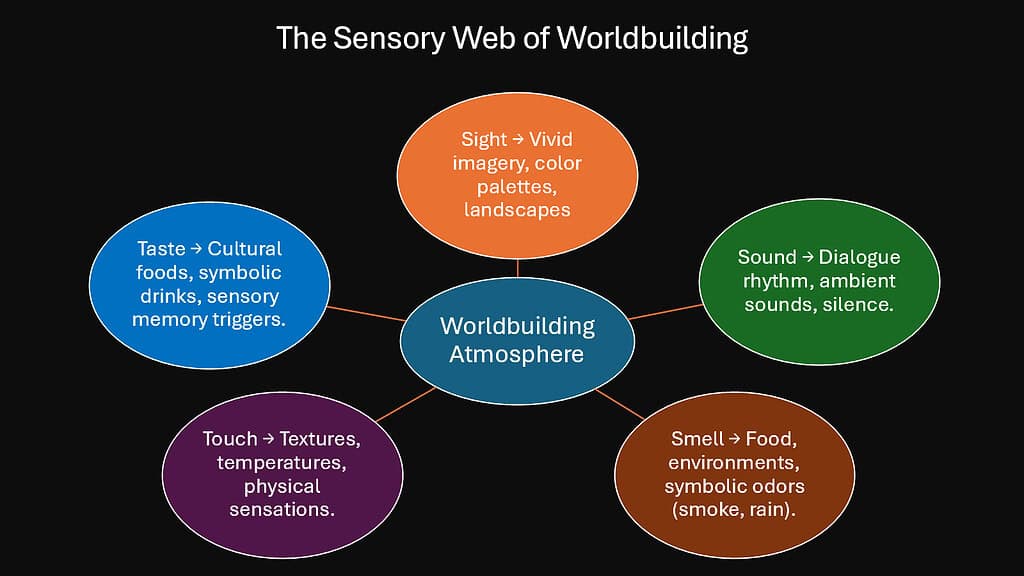
Sensory-rich worldbuilding creates lasting immersion by deliberately engaging multiple channels of human perception simultaneously. When writers skillfully incorporate sight, sound, smell, touch, and taste into their descriptions, they activate diverse neural pathways that make fictional experiences feel remarkably more real and tangible. This multisensory approach mirrors how people actually experience the physical world, creating authentic psychological responses that traditional visual-only descriptions cannot achieve.
Visual details alone cannot create fully immersive worlds that feel lived-in and authentic. Ray Bradbury understood this fundamental principle when crafting the dystopian atmosphere of Fahrenheit 451. His descriptions include the mechanical hound’s needle-sharp proboscis, the persistent smell of kerosene clinging to Montag’s hands, the crackling sound of burning books, and the metallic taste of fear. These carefully layered sensory elements create atmospheric depth and emotional resonance that purely visual descriptions cannot achieve, making readers feel physically present in the fictional world.
Smell and taste often carry the strongest emotional associations because they connect directly to memory centers in the brain’s limbic system. Marcel Proust masterfully demonstrated this neurological connection in In Search of Lost Time when the simple taste of a madeleine cake triggered profound recollections and emotional responses. Writers can strategically use similar sensory triggers to create powerful emotional resonance between readers and fictional worlds, establishing lasting connections that persist long after reading ends.
Sound creates a temporal dimension in worldbuilding. The constant drip of water in underground caves, the rhythmic hammering from a blacksmith’s forge, or the whisper of wind through alien vegetation establishes time’s passage. These auditory elements make worlds feel alive and dynamic rather than static descriptions frozen in time.
Table 3: Sensory Worldbuilding Techniques and Their Effects
| Sensory Channel | Worldbuilding Technique | Psychological Effect | Reader Experience |
|---|---|---|---|
| Visual | Color palettes and lighting | Mood establishment and emotional tone | Creates atmosphere and feeling |
| Auditory | Environmental sounds and rhythms | Temporal awareness and immersion | Establishes world’s living quality |
| Olfactory | Distinctive scents and aromas | Memory activation and emotional connection | Triggers personal associations |
| Tactile | Texture and temperature descriptions | Physical presence and realism | Creates embodied experience |
| Gustatory | Taste references and food culture | Cultural authenticity and comfort | Establishes social connections |
| Kinesthetic | Movement and spatial relationships | Physical understanding and navigation | Enables mental mapping |
3. Worldbuilding and Structuralism in Narrative Worlds
Structuralist literary theory reveals how worldbuilding creates profound meaning through carefully constructed underlying systems rather than superficial surface details. Claude Lévi-Strauss demonstrated that human cultures naturally organize reality through binary oppositions, symbolic structures, and mythological frameworks that provide meaning and coherence. Effective worldbuilding employs similar systematic approaches to create coherent fictional societies that feel authentically human while remaining imaginatively distinctive.
Mythological structures within story worlds provide essential frameworks for understanding complex narratives and cultural relationships. Frank Herbert’s Dune succeeds brilliantly because it presents complete, interconnected mythological systems governing the Fremen culture and their desert planet existence. The intricate relationship between water scarcity, desert survival techniques, and deeply held spiritual beliefs creates internal logic that readers can follow intuitively. These mythological structures feel genuinely authentic because they mirror recognizable real-world cultural patterns while maintaining fictional uniqueness.
Symbolic systems embedded thoughtfully in worldbuilding communicate deeper meanings and themes without requiring explicit explanation or heavy-handed exposition. The colors, architectural styles, social hierarchies, and cultural practices in fictional worlds carry significant symbolic weight that reinforces narrative themes naturally. Suzanne Collins used this approach masterfully in The Hunger Games by creating districts with symbolic specializations that reflect broader economic inequality and social commentary about power, oppression, and resistance.
Binary oppositions help organize complex fictional societies into understandable patterns. Light versus darkness, civilization versus wilderness, order versus chaos provide structural frameworks that readers intuitively grasp. These oppositions don’t require explanation because they tap into fundamental ways humans organize experience and meaning.
Table 4: Structuralist Elements in Worldbuilding Systems
| Structural Element | Worldbuilding Application | Meaning Creation | Reader Understanding |
|---|---|---|---|
| Binary Oppositions | Contrasting cultures or values | Clear moral and thematic frameworks | Intuitive comprehension of conflicts |
| Mythological Frameworks | Origin stories and belief systems | Cultural authenticity and depth | Connection to universal patterns |
| Symbolic Systems | Visual and cultural codes | Subconscious meaning communication | Emotional and thematic resonance |
| Social Hierarchies | Power structures and relationships | Political and social commentary | Recognition of familiar patterns |
| Ritual and Ceremony | Cultural practices and traditions | Community identity and values | Understanding of social cohesion |
| Language Patterns | Communication styles and dialects | Cultural distinctiveness | Authentic social differentiation |
4. Worldbuilding as Cultural Depth and Social Identity
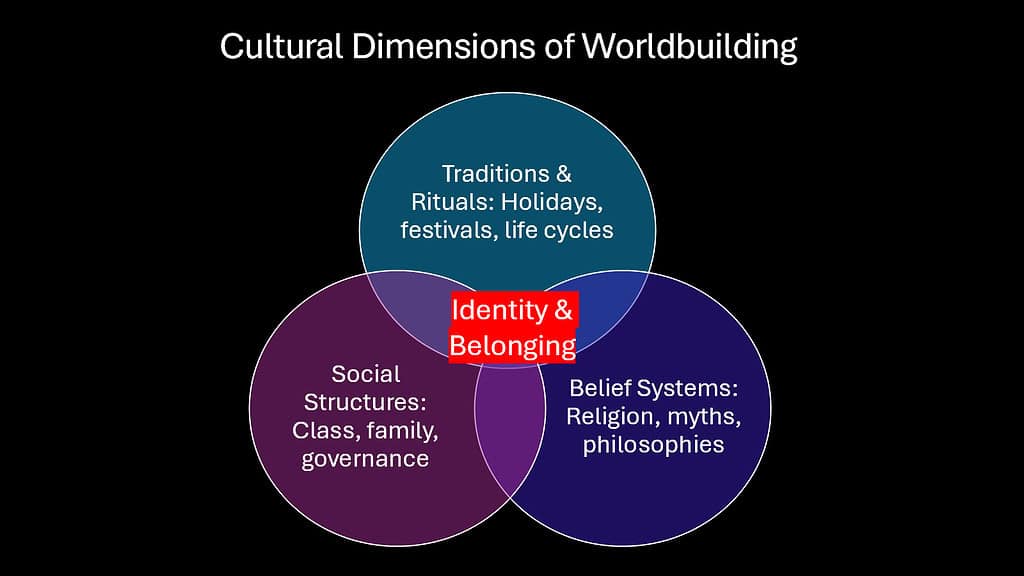
Believable societies within fictional worlds require authentic cultural foundations that resonate meaningfully with readers across different backgrounds, experiences, and worldviews. Successful worldbuilding draws inspiration from real cultural patterns and historical developments while carefully avoiding harmful stereotypes or oversimplification that might alienate readers. This balanced approach creates universal recognition and emotional connection while maintaining fictional distinctiveness that keeps stories fresh and engaging.
Social identity naturally forms through shared experiences, common values, and inherited traditions passed down through generations. When writers develop fictional cultures, they must thoughtfully consider how geography, climate, history, available resources, and external pressures shape social development over time. Ursula K. Le Guin’s The Left Hand of Darkness succeeds brilliantly because the planet Gethen’s harsh climate and unique biological characteristics logically influence its inhabitants’ social structures, gender concepts, and psychological development in ways that feel both alien and recognizably human.
Economic systems within fictional worlds profoundly affect every aspect of society from family structures and social mobility to artistic expression and political power distribution. The economics of magic in Brandon Sanderson’s Mistborn series creates logical consequences for social hierarchy, political power structures, and individual character motivations throughout the narrative. When worldbuilding includes realistic economic considerations and trade relationships, fictional societies feel more authentic, sustainable, and believable to readers who understand how resources shape human behavior.
Religious and philosophical systems provide meaning frameworks that govern character behavior and social interaction. These belief systems must feel internally consistent and emotionally satisfying to maintain reader investment. Terry Pratchett’s Discworld novels demonstrate how satirical religious systems can still provide meaningful philosophical commentary while remaining entertaining.
Table 5: Cultural Worldbuilding Components and Social Functions
| Cultural Component of Worldbuilding | Social Function | Worldbuilding Impact | Reader Connection |
|---|---|---|---|
| Traditional Practices | Community bonding and identity | Authentic cultural feeling | Recognition of human universals |
| Economic Systems | Resource distribution and power | Logical social consequences | Understanding of cause and effect |
| Religious Beliefs | Meaning and moral frameworks | Character motivation clarity | Connection to spiritual needs |
| Educational Methods | Knowledge transmission and values | Generational continuity | Familiar learning patterns |
| Artistic Expression | Cultural creativity and beauty | Aesthetic world enrichment | Emotional and creative resonance |
| Social Rituals | Life transition marking | Community involvement depth | Recognition of human ceremonies |
5. Worldbuilding and Reader-Response Theory in Storytelling
Reader-Response Theory emphasizes how readers actively construct meaning through dynamic interaction with texts rather than passively receiving predetermined messages. Wolfgang Iser argued that literary works contain deliberate “gaps” that readers must fill through imagination, personal experience, and interpretive engagement. Effective worldbuilding strategically creates these meaningful gaps while providing enough concrete detail to guide reader participation without overwhelming their creative involvement.
Implicit worldbuilding allows readers to infer cultural details, social relationships, and environmental features without explicit explanation or heavy-handed exposition. This collaborative approach makes readers feel like genuine co-creators rather than passive observers watching events unfold. When Kazuo Ishiguro describes the boarding school in Never Let Me Go, he provides atmospheric details and character interactions while leaving readers to gradually understand the institution’s true purpose through careful observation and emotional intelligence.
Mental mapping occurs naturally when readers construct spatial relationships and geographic understanding from carefully placed textual clues and character movements. Writers must provide enough navigational information for readers to orient themselves confidently while allowing individual imagination to fill in visual details and personal interpretations. This delicate balance between guidance and creative freedom creates personalized world experiences that feel unique and meaningful for each reader, enhancing emotional investment and personal connection to the story.
Cultural inference enables readers to understand social rules and behavioral expectations through character interactions rather than explicit exposition. When fictional characters navigate social situations naturally, readers learn cultural norms organically. This approach creates more engaging worldbuilding because it mirrors how people actually learn about new cultures in real life.
Table 6: Reader-Response Worldbuilding Strategies and Effects
| Worldbuilding Strategy | Reader Activity | Cognitive Engagement | Imaginative Result |
|---|---|---|---|
| Implicit Detail | Gap-filling and inference | Active interpretation and construction | Personalized world visualization |
| Atmospheric Suggestion | Mood interpretation and feeling | Emotional engagement and immersion | Subjective atmospheric experience |
| Cultural Clues | Social rule deduction | Pattern recognition and learning | Understanding of fictional societies |
| Spatial Navigation | Mental mapping and orientation | Cognitive organization and memory | Personal geographic understanding |
| Historical Hints | Timeline construction and causation | Analytical thinking and connection | Individual historical interpretation |
| Character Perspective | Subjective experience sharing | Empathetic engagement and identification | Personal emotional investment |
6. Worldbuilding for Consistency and Story Immersion
Internal logic and systematic consistency prevent cognitive dissonance that can suddenly break reader immersion and destroy carefully built emotional investment. When fictional worlds follow established rules consistently and maintain continuity throughout the narrative, readers can invest emotionally without fear that arbitrary changes will undermine their understanding or make their investment feel wasted. This reliability creates the essential trust necessary for deep engagement and lasting connection with fictional worlds.
Magic systems exemplify the critical importance of consistent worldbuilding rules and logical limitations. Brandon Sanderson’s laws of magic system design emphasize clear limitation, meaningful cost, and predictable consequence in all supernatural elements. When magical abilities have clear boundaries, understandable costs, and predictable results, readers can understand story conflicts, character choices, and plot developments without confusion. Arbitrary magic that appears whenever convenient breaks immersion because it violates fundamental reader expectations about cause and effect relationships.
Technological consistency requires deep understanding of how fictional innovations affect society, culture, economics, and daily life across all levels of civilization. Science fiction worldbuilding must carefully consider ripple effects of technological changes across all aspects of human civilization and social interaction. Isaac Asimov’s robot stories succeed because they explore the psychological, social, and ethical implications of artificial intelligence rather than focusing solely on technical capabilities or impressive gadgets.
Historical continuity within fictional worlds creates believable change and development over time. Even fantasy worlds require logical historical progression where past events influence present conditions. J.K. Rowling’s wizarding world includes historical events like goblin wars and magical conflicts that explain current tensions and social structures.
Table 7: Consistency Elements in Immersive Worldbuilding
| Consistency Element | Worldbuilding Application | Immersion Function | Reader Trust Building |
|---|---|---|---|
| Physical Laws | Environmental rules and limitations | Predictable world behavior | Reliable expectation framework |
| Social Systems | Cultural norms and hierarchies | Logical character interactions | Believable society function |
| Historical Timeline | Past events and consequences | Causal world development | Understanding of current conditions |
| Economic Logic | Resource scarcity and trade | Realistic social motivations | Authentic conflict understanding |
| Technological Integration | Innovation effects on society | Comprehensive world coherence | Systematic change comprehension |
| Character Continuity | Personality and growth consistency | Reliable relationship dynamics | Emotional investment security |
Conclusion: Worldbuilding as the Heart of Powerful Story Worlds
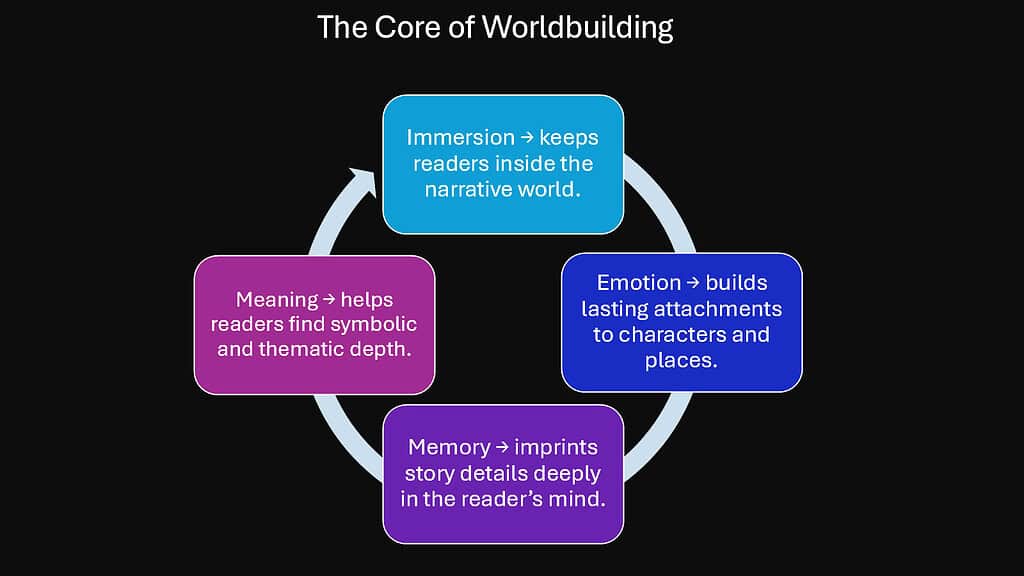
Worldbuilding transcends mere background decoration to become storytelling’s psychological foundation. The six approaches examined here demonstrate how effective world creation engages fundamental cognitive processes that govern human understanding and emotional response. When writers craft immersive worlds through archetypal structures, sensory richness, systematic consistency, cultural authenticity, reader collaboration, and logical continuity, they create experiences that resonate beyond entertainment.
These worldbuilding strategies work because they mirror how people actually process reality. The human brain constantly seeks patterns, builds mental maps, infers social rules, and constructs meaning from sensory input. Fictional worlds that engage these natural cognitive processes feel more real and emotionally compelling than those that rely solely on surface details or arbitrary invention.
The psychological dimension of worldbuilding explains why certain stories endure while others fade from memory. Worlds like Middle-earth, Hogwarts, or the Matrix continue inspiring new generations because they provide frameworks for understanding human experience rather than simple escape fantasies. They offer cognitive tools for processing complex realities while maintaining emotional safety.
Modern storytelling benefits from understanding worldbuilding as narrative psychology rather than creative decoration. Writers who grasp these psychological principles can create worlds that feel authentic, emotionally resonant, and intellectually satisfying. The goal extends beyond impressive imagination to crafting experiences that genuinely enrich human understanding and connection.
Table 8: Worldbuilding Psychology Integration for Story Impact
| Psychological Function | Worldbuilding Integration | Story Enhancement | Long-term Reader Impact |
|---|---|---|---|
| Pattern Recognition | Systematic world rules and logic | Predictable story coherence | Cognitive satisfaction and understanding |
| Emotional Processing | Culturally authentic experiences | Character motivation clarity | Empathetic connection and growth |
| Memory Formation | Sensory detail and atmospheric depth | Vivid story recollection | Lasting imaginative impression |
| Meaning Construction | Symbolic systems and thematic consistency | Interpretive depth and significance | Personal insight and reflection |
| Social Understanding | Realistic cultural and community dynamics | Relatable character interactions | Enhanced social awareness |
| Imaginative Engagement | Reader participation and inference opportunities | Active story co-creation | Creative inspiration and development |
What worlds will you build that transform readers into believers, explorers, and co-creators of meaning?



